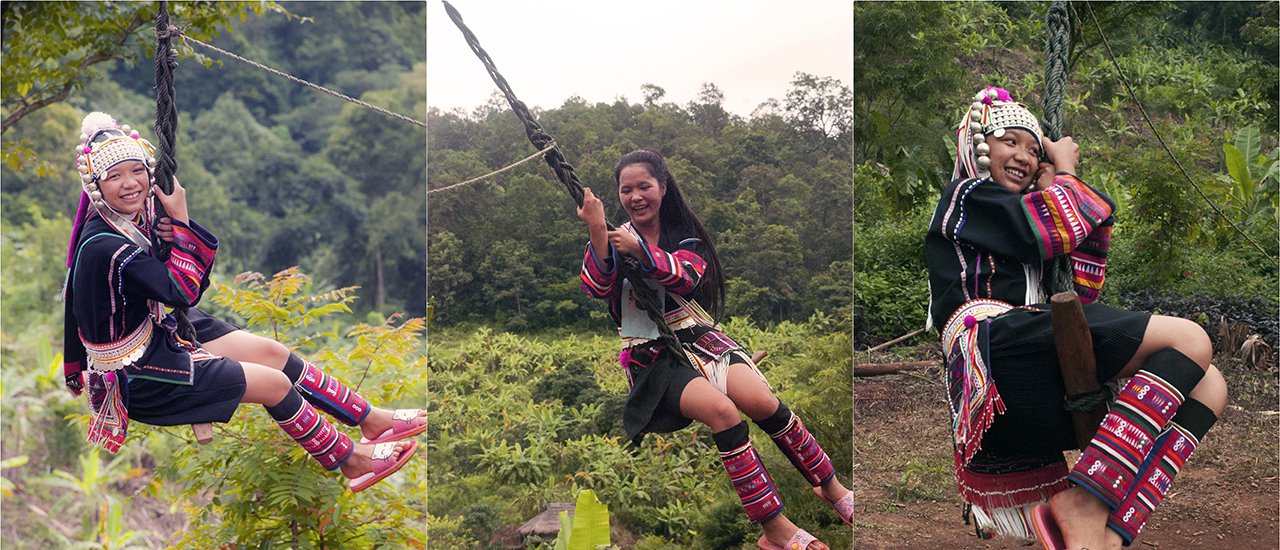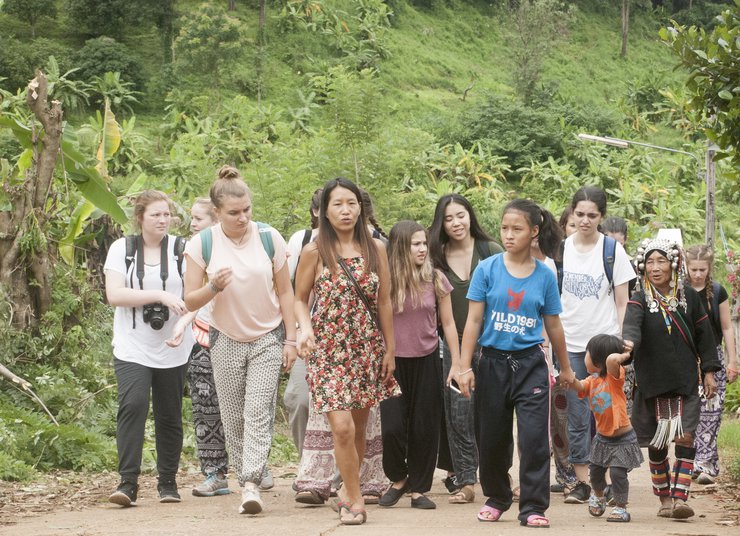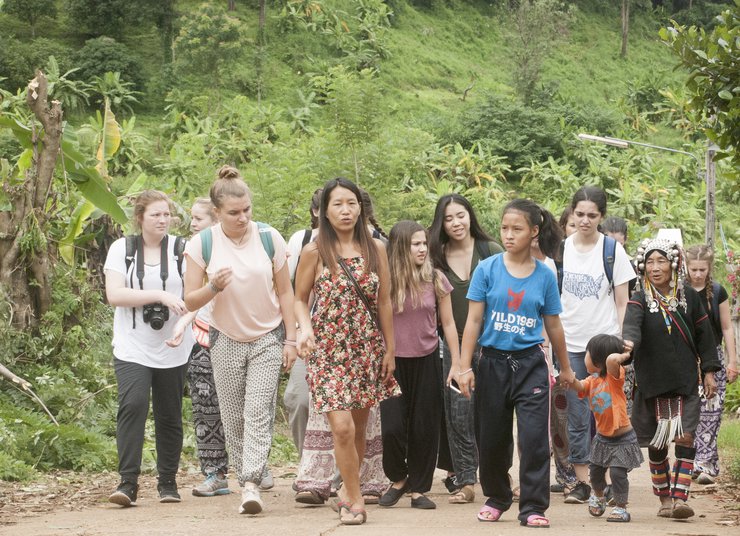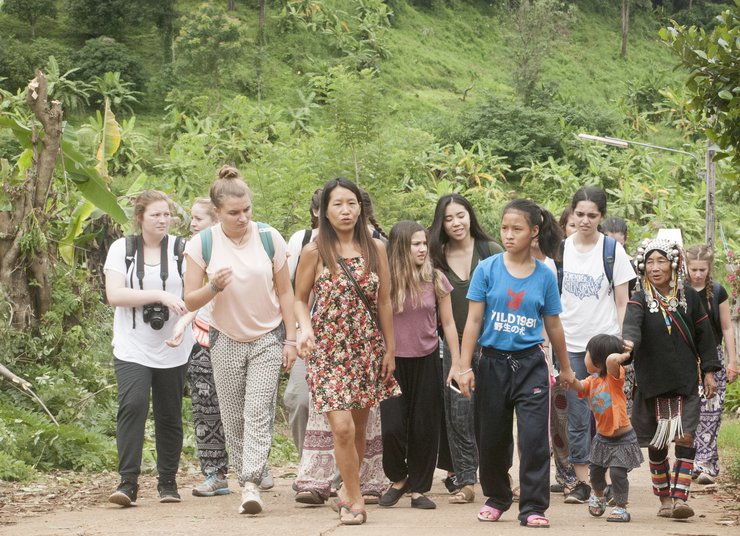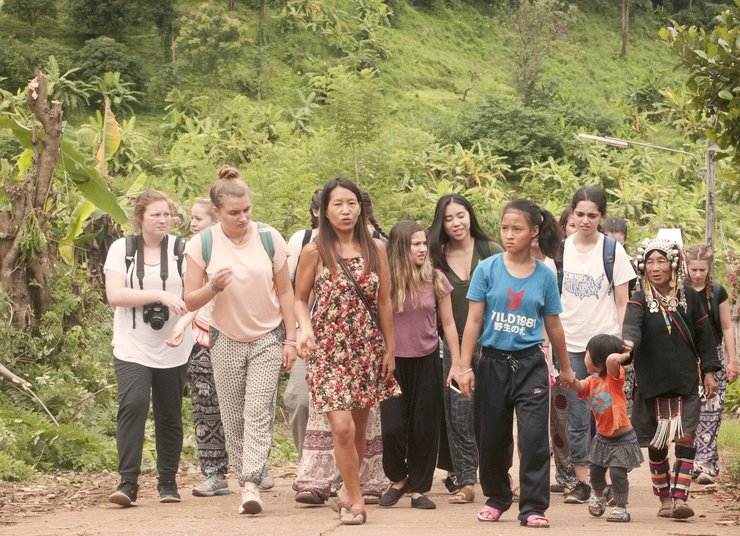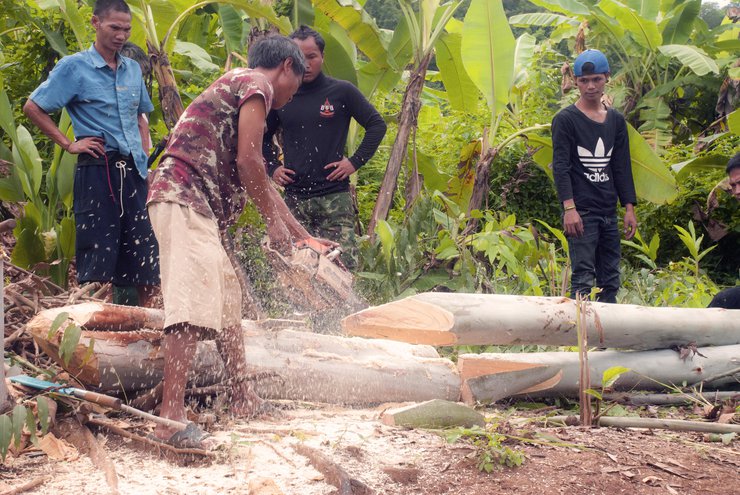On Mother's Day, August 12, 2016, I had the opportunity to witness a small act of beauty in a tiny village in Mae Taeng district, Chiang Mai province.
This year, Mother's Day falls on a long weekend, and the Akha people of Ban Huai Pong will return home to celebrate the annual Lo Swinging Ceremony, a local cultural tradition.
On the 12th day, villagers will build swings and carousels, also known as "La Cher" or "Gala La Cher".
On the 13th, there will be a swing performance at the village cultural square, also known as Daekhong.
They also visited houses of local wisdom, such as the spirit medium's house, also known as "Yi Pa", the weaving house, the spinning house, the knife-making house, the embroidery house, the hat-making house, and shopped for souvenirs at the community shops.

Ban Huai Pong is a tourist village where villagers are very familiar with tourists.

Popular among tourists who drive up to visit the village.
The general condition of the village can be imagined. The way up to the village is steep, which is a favorite for off-road enthusiasts.
The most challenging part was when the young men were building the swing. During the preparation, they clearly divided their responsibilities.
Men over 50 looking for the perfect tree, they say it must be at least 10 meters long.
During the operation, young men were tasked with digging, cutting, and carrying the bodies to a deep pit that had been prepared. It took 10 men to carry each body.
Meanwhile, the children will be ready to welcome adventurous tourists like us.
The following images show the steps to create a Galahad column.



Then, the young men tested the swing to make sure it was sturdy and functional. I couldn't help but ask if the rope had ever broken. They replied that it had, and one of them even joked, "It sent me flying into the banana grove over there, brother, but I was fine!"

The young man, strong and agile, would swing his legs and swing the swing high as shown in this picture. I tried, but I couldn't swing half as high. I was both tired and sore (weak indeed 55). A good swing can touch the top of the pole with their feet, you know. The younger ones say so.
"Sure, I'll go practice for another 10 years. Hehe."

Even talented people climb this high.
Another way for those who want to swing is to insert a stick. There is a technique to carving the stick for sitting. It must be in the middle, carefully calculated. When swinging, it will not wobble or tilt. On the ground, there will be people pulling the rope. The harder they pull, the higher it goes. The swinger also has a part to play. They must swing their feet to help the puller. Otherwise, the puller will run out of energy and get dizzy.
This year, they have specially made two swings for children (as shown in the cute pictures below).

Watching the children play, I couldn't help but laugh. It brought me so much joy.
Returning to the ground, each kitchen will be pounding rice cakes for this event. The method is to pound steamed glutinous rice until it becomes flour, then lift it onto fresh banana leaves, sprinkle with sesame seeds, and shape it into balls. It can be deep-fried or eaten fresh.


The Traditional Dress of the Akha People: A Glimpse into their Tibetan Ancestry
The Akha people, known for their vibrant and intricate attire, trace their roots back to the Tibetan Plateau. Their traditional clothing reflects this heritage, showcasing a unique blend of cultural influences and practical adaptations to their mountainous environment.
Key elements of Akha attire:
- Headwear: Elaborate headdresses adorned with beads, shells, and silver ornaments are a hallmark of Akha women's attire. These headdresses often symbolize social status and marital status.
- Embroidered jackets and skirts: Both men and women wear intricately embroidered jackets and skirts, often featuring geometric patterns and animal motifs. These garments are not only aesthetically pleasing but also provide warmth and protection in the cool mountain climate.
- Silver jewelry: Akha people are renowned for their exquisite silver jewelry, which adorns their necks, wrists, and ears. These pieces often feature intricate designs and hold cultural significance.
The influence of Tibetan ancestry:
The Akha people's traditional dress exhibits several elements reminiscent of their Tibetan heritage. The use of wool and sheepskin, common materials in Tibetan clothing, reflects the shared adaptation to a cold climate. Additionally, the vibrant colors and intricate embroidery techniques employed by the Akha people bear resemblance to those found in traditional Tibetan attire.
Conclusion:
The traditional dress of the Akha people serves as a testament to their rich cultural heritage and their enduring connection to their Tibetan ancestry. Each element of their attire, from the elaborate headdresses to the intricate embroidery, tells a story of their history, beliefs, and adaptation to their environment.
High-Angle View of a Village with a Swinging Pole (Galahala Zher)
This image presents a high-angle view of a village, showcasing a prominent swinging pole, known as a Galahala Zher. While the visual is captivating, it sparks a desire to delve deeper into the cultural significance and stories surrounding this unique structure.
Beyond the captivating visuals, the Galahala Zher invites exploration into the realm of folklore and tradition. The "ghost gate" beliefs of the Akhan people, the art of spinning yarn, and the intricate craft of knife-making all hold captivating narratives waiting to be unraveled.
This image serves as a springboard for a more comprehensive exploration, delving into the rich tapestry of cultural practices and beliefs associated with the Galahala Zher. A closer examination of these elements promises to unveil a deeper understanding of the village's history, traditions, and the lives of its inhabitants.

In addition to swinging, tourists can walk to the tourist spots within the village.
Huai Pong is a popular tourist destination for both Thai and international tourists. It is known as a major tourist attraction in Mae Taeng district, where tourists are seen driving up (image above). Some come from resorts or tour companies that bring tourists to visit the village and buy souvenirs.
The image below depicts a local museum exhibit showcasing a wooden doll, known as a "ghost door" in the Akha belief system.


Carved wooden figures of a man and a woman, Phi Gate, Akha Museum, Huay Pong Village.

A demonstration of spinning yarn, transforming cotton from a round ball into thread using a spinning top-like tool, before weaving it into fabric.

This house sews skirts.

Children can enjoy the trip, and the elderly can also enjoy it. The picture shows a group photo of the Akha people's village of Huai Pong on Mother's Day.
Travel Information
This section provides information on how to reach the destination.
- Depart from Chiang Mai city via Chiang Mai-Mae Rim Road
- Head towards Mae Taeng district, the road will run alongside the Mae Taeng River.
- Located on Road 107, the marker is at Mae Malai Market.
- Look for the sign for "Akha Village, Huai Pong" and follow it to reach Kaeng Kuet.

Although the Lo Chinchin ceremony is not taking place, tourists are still welcome to visit.
The Akha people of Huay Pong smiled warmly.
the end 230859
ginnagan
Friday, September 27, 2024 10:23 AM

